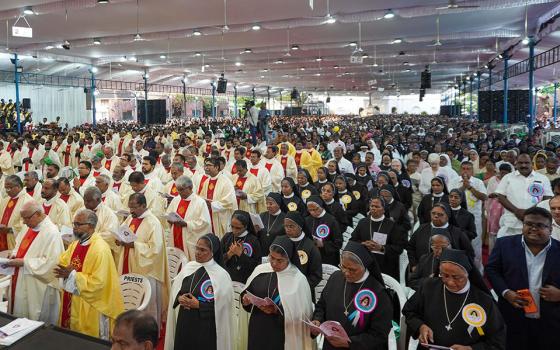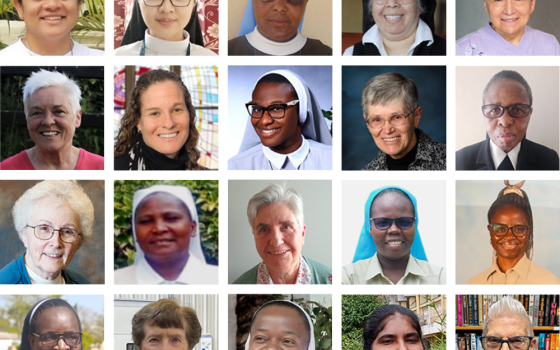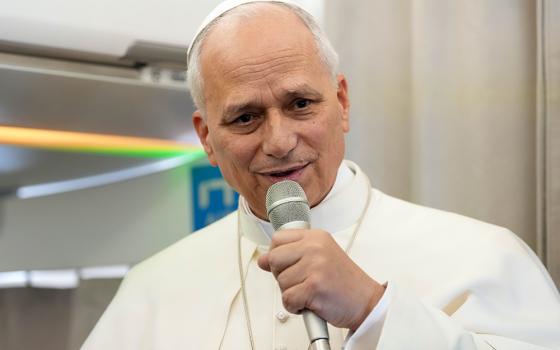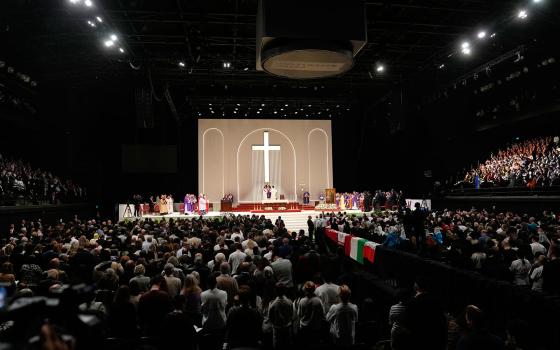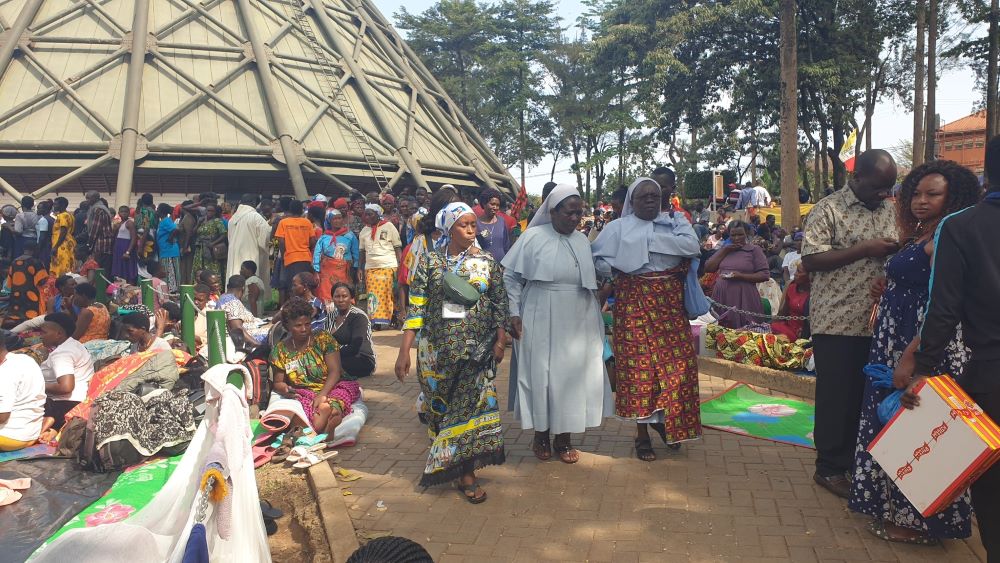
Catholic sisters are among the crowd gathering at the Uganda Martyrs Shrine of Namugongo in Kampala, Uganda's capital, to honor the 22 Catholic and 23 Anglican martyrs killed between 1885 and 1887. Martyrs Day, June 3, is a national holiday in Uganda and a major spiritual event across Africa. (GSR photo/Gerald Matembu)
As the first light breaks over the dusty roads of eastern Uganda, Sr. Stella Aketch adjusts her veil and tightens the straps of her sandals. She is among hundreds of thousands of pilgrims making the long journey on foot to the Namugongo shrine ahead of Uganda's annual Martyrs Day celebrations on June 3.
"I'm happy to join this pilgrimage. It's a sacrifice — just like the one Jesus made for us," said Aketch, a member of the Little Sisters of St. Francis. "The Ugandan martyrs also gave their lives for their faith. Walking like this is my way of honoring their courage."
Martyrs Day is one of Africa's largest religious gatherings, drawing more than 2 million pilgrims each year from Uganda and neighboring countries including Kenya, Tanzania, Rwanda, South Sudan and the Democratic Republic of Congo. Many pilgrims spend days or even weeks walking in the heat, rain and mud, facing exhaustion and blisters as they approach the sacred site northeast of Kampala.
The shrine commemorates 22 Catholic martyrs and 23 Anglican converts who were executed between 1885 and 1887 by King Mwanga II of Buganda. Many of the victims, young men serving in the royal court, were killed for refusing to renounce their Christian faith. Some were speared to death, others burned alive. Their steadfastness has become a symbol of faith and resilience in the region.
Pope Paul VI canonized the Catholic martyrs in 1964. Pope Francis visited the shrine in 2015, calling the martyrs "true witnesses" of the Gospel. Their feast day on June 3 is a national holiday in Uganda and a major spiritual event across Africa.
"The martyrs are our spiritual ancestors. Their witness calls us to live with peace, forgiveness and faith even when life is difficult," said Fr. Leonard Magombe of Muyembe Parish in eastern Uganda. He led more than 250 pilgrims toward Namugongo.
"They came from different backgrounds and churches, but stood united in faith," he said. "That's the message we carry today."
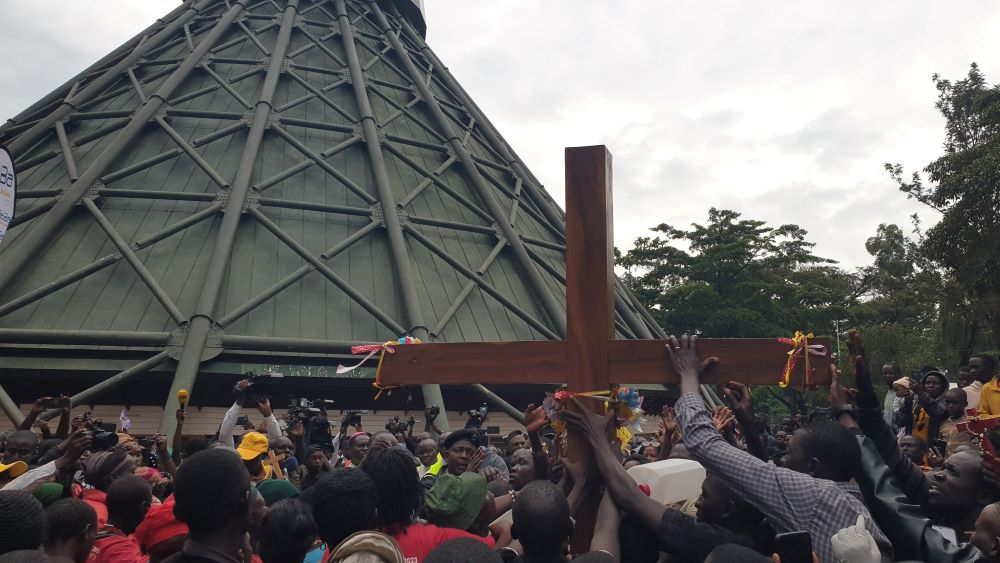
Uganda Martyrs Catholic Shrine Namugongo is one of the largest Christian pilgrimage destinations in Africa, dedicated to the 22 Catholic and 23 Anglican converts martyred for their faith in the late 19th century. (GSR photo/Gerald Matembu)
A journey of spirit and sacrifice
For many Catholic sisters, the pilgrimage is not just a test of endurance but a spiritual discipline. Congregations often walk together, singing hymns, reciting the rosary and praying for personal and communal intentions.
Sr. Jackline Auma, from the Little Sisters of Mary Immaculate of Gulu, said her prayers this year are focused on young people, her congregation and her family.
"I'm walking for faith — to ask God for strength in these challenging times," she said. Auma and a group of sisters are walking more than 200 miles from Gulu, in northern Uganda, to the shrine.
The journey is grueling. Along the way, they sleep in church halls or makeshift tents, relying on donations of food, water and basic medical supplies from local communities.
"It humbles you," Auma said, her voice hoarse from singing. "When people see sisters walking, it gives them hope. Every blister and sore is a prayer."
Magombe reminded pilgrims that the journey is more than a religious excursion. "This is not a tour. It's a spiritual journey," he told them. "We start small, like a stream, but grow stronger together. It will take us four days to reach Namugongo."
Steps fueled by faith and hope
Clad in simple clothes and carrying rosaries and backpacks, the pilgrims sing praise songs and chant as they walk. For many, it's a journey of healing, thanksgiving or intercession.
Many pilgrims believe that visiting the shrine can bring healing, hope and divine intervention. Over the years, people have testified to receiving miracles such as physical healing, answered prayers and life breakthroughs after praying there.
Advertisement
Beatrice Nagibogolo, a mother from eastern Uganda, said fatigue couldn't stop her. "This is my second pilgrimage," she said. "I'm asking God to bless my children and help me build a decent home."
Joseph Musimbi, from Kenya's Vihiga region, began walking in early May. He said he's seeking divine protection for his family, which he believes is under spiritual attack.
"I believe my prayers will be answered when I reach the shrine," he said. "This pain, these blisters — they're nothing compared to the reward of healing and peace."
The Ugandan government supports the event by providing security, medical services and logistical coordination. This year, the Diocese of Lugazi will lead the national celebration, organizing choirs, liturgies and cultural performances for the main Mass.
Martyrs Day has also gained global interest, drawing visitors from countries such as Nigeria, Italy and the United States. For many, the story of the martyrs remains timeless.
"They speak not through words, but through sacrifice and love," said Auma as she paused near a hillside chapel, just 30 kilometers (9 miles) from the shrine.
As June 3 nears, the roads to Namugongo swell with the sound of prayer and the rhythm of countless feet. Pilgrims press forward — weary, hopeful and united in purpose.
"To those walking from all over, don't give up," Aketch said. "And to those who've never joined us, come and see for yourself. It's a sacrifice worth making."



